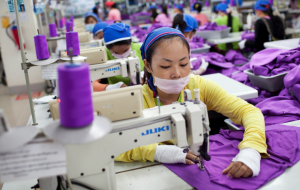Fast Fashion. It’s a term used for mass produced, trendy, inexpensive clothing. But the ever-so-attractive low price tag comes with consequences.
Fast fashion pieces are often made using low quality materials. This is a big reason for the inexpensive pricing on many websites that are complacent in fast fashion production, like Fashion Nova, Shein and Forever 21.
What you didn’t know about fast fashion
“Most of our clothes are made in places where workers’ rights are nonexistent.”
This is the tagline on the home screen of an independent platform called Sustain Your Style. The goal of Sustain Your Style is to spread awareness about some of the current “bad practices” in the fashion industry.

These issues include but are not limited to child labor, unsafe work conditions, and unfair pay. The amount of ways a company can exploit their workers and save themselves money in the process is shocking.
168 million children in the world are forced into working. Since working in textiles and fashion typically requires a low skill set, children are seen as a “perfect fit” for these jobs in fast fashion textile production.
Unsafe working conditions are also extremely common. Employees are usually forced to work extreme hours with little to no breaks. Not to mention many of the factories are not built to sustain the materials being produced and machinery being used.
If you have children working for you, why pay them what an adult would earn? If you have employees working in terrible work environments, why pay them what they deserve? This is the mentality of so many fast fashion companies.
Most fast fashion workers are not even paid a live-able wage. This means that even if they work “normal” hours or overtime, they still are not earning enough to provide themselves with the basic necessities of life.
In 2018, the Fair Labor Association conducted a study and learned that the average garment worker in Bangladesh would need an 80% raise in wages to even come close to what a “typical” living wage is.
It is interesting to note that since these findings, minimum wage has gone up in Bangladesh and this enormous pay gap still remains.
Although these workers see very little money, it is disheartening to know that if you are supporting these companies financially, you are telling them that you condone the way they do their business. As these companies grow in popularity, the workers never see financial compensation.

What are the ethical ramifications?
In today’s world of influencers and Instagram models, it’s hard to not feel pressured to constantly buy more pieces in order to stay on trend. Unfortunately, this is a big reason that fast fashion thrives. These brands profit heavily off of being able to push their on-trend and affordable pieces to the world.
It’s so easy to fall victim to fast fashion because it is nearly everywhere you look. If you don’t see paid advertisements, you see social media users promote it or do “clothing hauls.” But, does anyone ever talk about the ethical issues that are coupled with fast fashion production?
It all comes down to what keeps you up at night. If you can go to sleep at night knowing that your hard earned money supports such unethical practices, then so be it! But, a lot of empathetic people today would love to see a change made that involves the fall in fast fashion popularity.
Spending a little more money can make the difference in supporting a company who pays their workers a fair wage and a company who doesn’t. If you are spending $6 on a dress, it is likely that the worker was paid pennies to the dollar for their time spent making it.
Not to mention that the material will surely not hold up- it’s safe to say almost every girl has experienced their new Forever 21 shirt ripping or shrinking upon the first wear or wash.
If you think about your wallet, you’re doing yourself a disservice by shopping fast fashion. You can buy all the cheap clothes you want, but they will not hold up nearly as well as something produced ethically! Paying more for better quality may seem scary at first, but it can be so rewarding.
The sooner your clothes start to fall apart or shrink, the sooner you have to buy more clothes- so why not just spend the money on staple clothing items that will be able to stay in your closet for years?
What can you do?
Educating yourself and those around you can make a world of difference. A group of like-minded individuals got together in southern Delaware to organize an event to promote sustainable shopping.
The event, called Second Swell, took place during an April weekend and was essentially a flea market for gently used and new clothes and accessories.
The Second Swell team called upon anyone who was willing to donate clothing and accessories in order to provide a sustainable shopping event for the local community. Those who donated paid a small vendor fee, and then were able to price their own items from $5 – $30.
Vendors received 100% of their sale price if any of their items were purchased, and any items that were not purchased at the end of the event were donated to the Delaware Coalition Against Domestic Violence. The team at Second Swell took their sustainability efforts a bit further with an entry fee to the event, which was donated to the Delaware Center for the Inland Bays.
Not only did this event raise money for charity, it helped broadcast sustainable shopping to a large variety of people. Many of the founders of this event work locally in retail and are passionate about making a difference in the world of sustainable shopping.

Lauren Slacum of southern Delaware is one of the founders of Second Swell. She has over 10 years of great retail experience in both mom-and-pop shops and large corporate settings. Slacum wants everyone to know that you don’t have to be a professional to shop sustainably and consciously.
“Next time you’re shopping, ask yourself- ‘Do I want this because I love it? Or do I want this because it’s cheap?”
Slacum thinks it’s best to save your coin if you’re only buying something because it is inexpensive. Doing some basic brand research and making small changes in your spending habits over time can be a good place to start if you’re trying to stop supporting fast fashion.
Closing
Fast fashion would not have a market if consumers did not buy from them. In a perfect world, one could advocate for sustainable fashion enough to eliminate fast fashion. As long as people continue to shop at Forever 21, Shein and so many more, fast fashion is going to continue to grow. Small steps towards eliminating the popularity of fast fashion can lead to big changes down the road.


